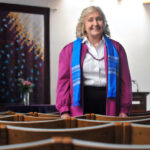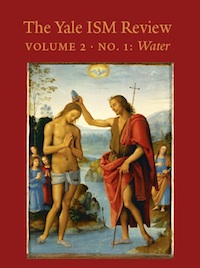Talitha Arnold
On June 12, 2011, we celebrated our first “Blue Pentecost” at the United Church of Santa Fe. Like churches around the world, we had traditionally based our Pentecost celebrations on the Acts story, with its “mighty wind” and “tongues of fire.” Pentecost at United was always red, noisy, and fun. We would fill the Sanctuary with red balloons and hang the red Pentecost banner. Children and adults blew like the wind, spoke in different languages, and waved slips of red paper above their heads as their “tongues of fire.”
But that year, everything changed. Santa Fe, like the rest of the Southwest, was in the grip of a decades-long drought. Ten days before Pentecost and hundreds of miles west of Santa Fe, an abandoned campfire in Arizona’s White Mountains started the largest fire in the state’s history. Fueled by tinder-dry forests and grasslands, it raced into New Mexico. By the Monday before Pentecost, its smoke descended upon Santa Fe. The normally azure sky turned grey. The smoke blocked the sun by day and turned the moon blood-red by night.
As the Southwest continued to burn, we knew our worship couldn’t include the traditional symbols of wind and fire to represent God’s spirit. So we designed a “Blue Pentecost,” based not on the Acts story, but on Jesus’ baptism—another time when God’s Spirit descended to fill someone with power. Water—not fire—became our central symbol of Pentecost. We hung the blue baptismal banner and used hymns such as “Spirit of the Living God, Fall Afresh on Me.” Rather than slips of red paper as tongues of fire, the children used pinon branches to bless the congregation with water from the baptismal font, as we sang John Chisum’s “Let Your Spirit Come:”
Let your rain fall down, pour upon our souls.
Come and wash us now; come and make us whole.
Our “Blue Pentecost” didn’t follow the usual script for worship that year. But the congregation definitely experienced God’s powerful spirit poured out upon us and all creation in that dry and harsh time. The story of Jesus’ baptism, the prayers and songs for rain, and especially the feel of those drops of water from the baptismal font renewed our spirits as surely as the tongues of fire had energized the apostles that first Pentecost.
The “Blue Pentecost” is one way our congregation has adapted our liturgy to life in a land of little rain. Although Christianity, like Judaism and Islam, arose in the arid lands of the Mideast, much of the American Protestant tradition historically comes either from the green hills of Germany and England or the equally green landscapes of New England and the American South. Our hymnody, prayers, and even church architecture often reflect our attachment to the “fields, forests, and flowery meadows” of colder climes. With its steeply-slanted roof to keep the snow off, the Congregational (UCC) Church of my Arizona childhood could have come from the New Haven Green. At Christmas, we sang “in the bleak midwinter, snow on snow” when it was 70 degrees outside and it hadn’t even rained for months.
The issue is not simply aesthetics or the cognitive dissonance of singing about lush landscapes when we’re surrounded by desert. When our worship affirms God’s beauty only in green forests and verdant meadows (the landscape many current desert-dwellers left behind), then despite its abundant and tenacious life, the desert is seen as “God-forsaken” or as Belden Lane’s “fierce landscapes” of trial and temptation. It is not “home.” The results have included not only transplanted New England-style churches, but also and especially the development of unsustainable desert cities like Phoenix with its green lawns and verdant golf courses. If worship in the desert fails to connect our congregations with the sacred creation outside the sanctuary doors, we will fail to love and save this unique corner of creation.
When, after a ten-year sojourn in the green hills of Connecticut, I became pastor of the newly-formed United Church of Santa Fe, I saw part of my call as making the connection between worship and the desert. Just as the magnificent saguaro cactus is adapted to life in the desert we hoped to grow a “saguaro church” with deep roots its natural environment. It was a commitment shared by the congregation’s founders. The church’s original covenant affirms that we will “live in harmony with all creation” and “give ourselves to the challenges and opportunities” of life in this high desert setting. Even the architecture bears witness to that commitment. One wall of the sanctuary is adobe. The Pueblo-style roof is flat. The original entrance to the church has an “acequia,” a turquoise-tiled fountain that stretches the length of the sanctuary and serves as a reminder of both the waters of baptism and the irrigation ditches (“acequias”) that give life to the communities of New Mexico.
Worship at United reflects our “desert faith” in various ways. For Children’s Sundays, the Parable of the Mustard Seed became the Parable of the Pinon Tree (of northern New Mexico) and the Saguaro (the giant cactus of the Sonoran Desert). Like the mustard seed, both plants grow from the smallest of seeds into great trees that provide shelter and life for other creatures. They also illustrate how to live in dry times: grow deep roots; adapt to change; acknowledge our dependence on one another; and seek God’s living waters.
In Lent, we use biblical images of water to speak of our thirst for God. Here is an example of a prayer that makes this connection:
In the deserts of our lives, in the wilderness within,
God gives us the waters of new life.
To give us hope when our lives run dry, to give us strength when our world seems barren,
God gives us the waters of new life.
To make justice roll down like waters and righteousness like a living stream,
To give us—and our world—a second chance and a new beginning,
God gives us the waters of new life.
In the Sacrament of Baptism, we include a question for the congregation that links the holy water in the font to God’s sacred gift of all water:
As we bless this water of Baptism, will you give thanks for God’s gift of water in all ways and recommit yourself to the wise use of this sacred resource for the sake of generations yet to come?
We also seek to learn from other desert peoples who have lived and prayed in this land far longer than any of us Protestants. For example, in both Native and Biblical traditions, prayers for rain are connected to prayers for a right relationship with the Creator and the rest of creation. The rains come when harmony and justice are restored. These traditions help us understand our own faith better. In times of drought or fire, we pray:
For rain in a thirsty land and hope in a hard time,
For all creation that suffers because of drought or human greed,
For the remembrance of the Source upstream and our neighbors downstream,
Lord, hear our prayer.
The continual incorporation of desert images, prayers, stories, and understandings in the worship life of the church shapes the rest of our life and ministry. Six years ago, the congregation adopted a “Whole Earth Covenant” that has led to practical projects such as solar panels and water conservation systems.
United’s “desert worship” not only connects us to the natural world outside the church. It also helps us draw on the deep well of God’s presence in the driest of emotional or spiritual times. Experiences of such dryness can be found in all congregations, regardless of where they are located. Every Sunday, people come through our doors from the deserts of their lives—divorce, job loss, a bad diagnosis, or other harsh and lonely places. Like the deer that longs for cool streams, they are thirsty for the living waters of hope, faith, and love.
From the story of Hagar in the wilderness to Moses striking the rock to Jesus asking a Samaritan woman for a drink, our Biblical faith abounds with the promise that God will provide that living water in the deserts of our lives. When our liturgy incorporates the lessons and practices of a desert faith, worship makes good on that promise.
 Talitha Arnold (YDS, ’80) was called in 1987 as Minister of United Church of Santa Fe, a new UCC congregation in the desert Southwest. Known for its worship, music, commitment to the wider community, and children’s and youth ministries, the church participated in the 2011 ISM “Congregations” project. Talitha also served congregations in Connecticut and Arizona and as Associate Chaplain for Yale. Author of Worship for Vital Congregations (Pilgrim Press) and articles for Feasting on the Word, The Christian Century, and NPR’s All Things Considered, her current work is A Desert Faith for a Desert Time (funded by the Louisville Institute).
Talitha Arnold (YDS, ’80) was called in 1987 as Minister of United Church of Santa Fe, a new UCC congregation in the desert Southwest. Known for its worship, music, commitment to the wider community, and children’s and youth ministries, the church participated in the 2011 ISM “Congregations” project. Talitha also served congregations in Connecticut and Arizona and as Associate Chaplain for Yale. Author of Worship for Vital Congregations (Pilgrim Press) and articles for Feasting on the Word, The Christian Century, and NPR’s All Things Considered, her current work is A Desert Faith for a Desert Time (funded by the Louisville Institute).
